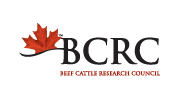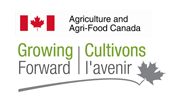Producing beef with lower GHG emissions and using fewer resources
| Project Code: | ENV.02.13 |
| Completed: | 2015 |
Project Title:
Defining the Environmental Footprint of Canadian Beef Production
Researchers:
Tim McAllister, Ph.D. and Karen Beauchemin, Ph.D. tim.mcallister@agr.gc.ca
Roland Kroebel Ph.D. and Shannan Little (AAFC Lethbridge), Getahun Legesse Ph.D., Kim Ominski Ph.D. and Emma McGeough Ph.D. (University of Manitoba) and Douglas MacDonald Ph.D. (Environment Canada)
Background:The beef industry is maligned for producing greenhouse gases linked to climate change. Practically every living organism produces greenhouse gases (including plants), but cattle produce more than other livestock because rumen bacteria produce methane as they digest feed. Additional greenhouse gases come from manure (methane and nitrous oxide) and fossil fuel use (carbon dioxide). However, the greenhouse gas impact of the beef industry is often vastly overstated.
In 2010, the United Nation’s Food and Agriculture Organization (FAO) released a report called “Livestock’s Long Shadow” which stated that livestock produce more greenhouse gas emissions than transportation, leading to headlines suggesting that burgers are worse for the planet than SUV’s. It was significantly flawed and a more balanced FAO report named “Tackling Climate Change Through Livestock” came out in 2013. This more balanced, but less publicized report found that producing a kilogram of beef in Latin America, India or China generates twice the methane as in North America, Europe or Australia. In countries with more sophisticated production systems, cattle are bred, fed and managed in ways that produce faster, more efficient growth. As a result they reach slaughter weight sooner, and spend fewer days eating, ruminating, producing methane and generating manure.
Objective:Evaluate how the greenhouse gas emissions associated with Canadian beef production changed between 1981 and 2011.
What They Did:These researchers looked at many different Canadian research projects that examined how slight changes in reproductive rate, feed and forage crop yields, growth rates, carcass weights, etc. impact how much feed and land is needed to produce a kilogram of beef, and how much manure and greenhouse gases are produced as a consequence. A variety of data sources (e.g. Census of Agriculture data from Statistics Canada, Canadian Beef Grading Agency, Canfax, and large-scale producer surveys) were also used. Dairy steers that entered feedlots and cull dairy cows were considered to produce beef, but veal calves were not. A range of cow-herd winter feeding management practices (confinement, in-field feeding, swath-, bale- and stockpiled grazing) and feedlot production scenarios (calf-fed, backgrounded, and backgrounded-grassed before finishing) were considered. They also accounted for regional differences in diets (corn-based feeding in the east vs. barley-based feeding in the west).
The research data was combined with the production data, and a computer model was used to estimate how resource requirements (land base and breeding herd size) and greenhouse gas production changed over the 30-year period.
What They Learned:Canada produced 32% more beef in 2011 than in 1981. Much of this was due to higher carcass weights; in 2011, slaughter steers were 29% heavier and heifers were 45% heavier than they were in 1981.
Producing the same amount of beef in 2011 required 29% less breeding stock, 27% fewer slaughter cattle and 24% less land, and produced 15% less greenhouse than in 1981.
Although some greenhouse gas emissions were from manure methane, CO2 (e.g. fuel use) and nitrous oxide from manure and soil, nearly three quarters of greenhouse gas emissions were due to enteric methane produced during digestion. Over 78% of the methane emissions occurred in the cow-calf sector, because the breeding herd spends nearly its whole life consuming forage-based diets that produce a lot more methane than grain-based diets do.
What It Means: Reductions in the beef industry’s environmental hoofprint have largely come through technologies that improve production efficiencies. On the cow-calf side, optimizing nutrition improves growth and reproductive performance. When more females get pregnant and successfully wean a calf, fewer heifers need to be retained as replacements, so the breeding herd is smaller. On the feedlot side, heifer carcass weight has increased due to growth promotants that overcame the biological disadvantages that heifers have relative to steers. Improvements in feed crop yields mean that a smaller land area is needed to produce the same amount of feed. In other words, many of the same things that improve productivity on the farm, ranch or feedlot also contribute to a smaller environmental hoofprint for the beef industry.
This research team will use similar analyses to estimate how the Canadian beef industry and the pastures and rangelands it maintains impact water, carbon sequestration and biodiversity. Those results are expected in 2018.








